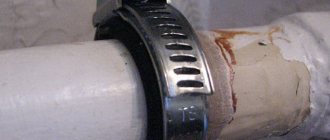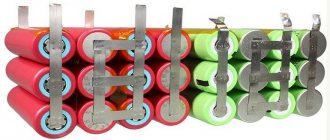Sealing threaded connections in heating, water and gas supply systems is perhaps the most important task for a plumber or gas equipment installer. Not only the normal functioning of the system, but also the safety of the structure in which it is installed depends on the quality of the work performed. The threaded connection itself is very strong, but it is not capable of holding liquid or gas without special treatment. There are quite a few means for sealing, one of them is a special polymer thread for sealing threaded connections, which will be discussed.
“Moment Germent”, length 15 m.
Linen seal
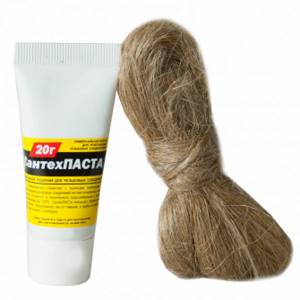
Sanitary paste is used to process flax, otherwise it will rot and crumble on the hot water supply (DHW) pipe, and it will rot on the cold water supply (CW) pipe. A water supply threaded connection treated with paste can be adjusted (corrected by turning it backwards) at an angle of up to 45°, parts are easier to screw on, and the thread is protected from corrosion.
Advantages:
- the lowest price;
- flax seals threads of all sizes;
- The surface is suitable in any condition: dirty, wet, rusty, damaged.
Flaws:
- It is difficult and time-consuming to work with linen sealant;
- hands, pipes and instruments are always dirty from flax fibers and paste;
- when tightened and swells, it creates stress in the thread.
Flax is good for sealing connections between metal pipes and fittings, but thin-walled parts and small threads must be handled with care. Of the combined elements, it is better to take those whose plastic part is made of more elastic polypropylene.
It is impossible to seal joints of parts made entirely of plastic with flax - due to the high tightening torque, damage to the walls and thread breakage is possible.
FUM tape
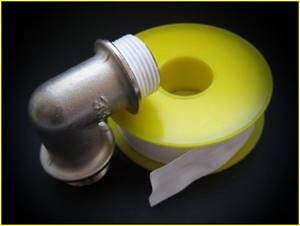
Advantages of fluoroplastic sealing material:
- soft, parts are easy to screw in and unscrew, you don’t have to worry about breaking or cutting new threads with metal on plastic due to strong compaction;
- The cleanliness of the threaded surface does not matter;
- almost doesn't get dirty.
Flaws:
- even with a slight displacement of the connection, leakage is possible;
- If the thread is tightened incorrectly, it is impossible to align the thread by feeding it back; an attempt will lead to leakage; the connection can only be disassembled and reassembled by re-winding the tape.
For beginners, FUM tape for sealing water pipes creates the most problems. It is advisable to use it in temporary engineering systems or where a slight leakage is not critical, for example, in a country water supply system.
Parts made of any material with medium-sized threads in good condition are suitable for sealing. The material is safe when sealing thin-walled fittings. It is contraindicated to seal threads on a water pipe with tape in case of possible shifts, in the area of impact loads or vibration.
How to seal a joint with flax?
When sealing threaded connections, you need to be very careful. Accuracy is the key to ensuring that nothing leaks. When working, you will need a special paste, which you cannot do without. It can be applied to the thread immediately or to already wound flax.
Paste gets your hands dirty. It's not very pleasant to wipe them off. Therefore, there is a life hack - the installer first sits down, winds flax onto a threaded connection, checks the quality of the winding (everything should be smooth) and then uses the paste, making a dozen connections at once. The connection must be free of protruding hairs, the first two turns remain free so that you can safely screw the coupling onto the external thread. And towards the end of the thread a roller or thickening is formed.
All compaction occurs on the last two threads. They are not completely cut through, smaller than the other turns. They are sealed by gluing the sealing material between the two parts.
Plumbing thread

It consists of polyamide microfibers coated with silicone. Very durable, impossible to tear with your hands.
Advantages:
- seals any thread equally well: old, corroded, wet, damaged;
- After compaction, adjustment up to 180° is possible;
- the tightening torque is less than when using flax, it is easy to assemble and disassemble;
- less FUM tape gets dirty.
Disadvantage: several times more expensive than flax, the price is comparable to FUM tape.
Even a non-professional can work with thread; technically, it is the simplest sealant. Can be used without restrictions on all types of connections, especially convenient for threads with fine pitches. For plastic parts, the thread must be used quite carefully.
Main types of pipe seals
From the entire arsenal, the following can be distinguished:
- Linen
- Adhesive sealant
- Silicone
- A thread
- FUM tape
The question “which pipe sealant is better and which is worse?” - incorrect. In order to understand this question, it needs to be posed somewhat differently: “What type of sealing of threaded connections should be used in specific conditions?”
Let's start with what sealant should not be used for threaded connections:
- Silicone (good for flange connections);
- Ship's red lead;
- Whitewash, various types of paints.
So, there are 4 types of material left:
- Linen;
- Thread;
- Adhesive sealant;
- FUM tape.
Silicone tape
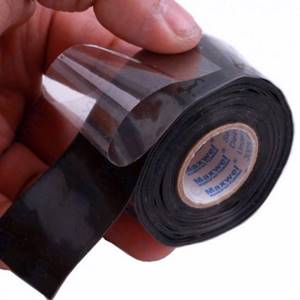
It combines the advantages of these materials. It differs better from FUM tape in its resistance to vibrations and the ability to adjust at an angle of up to 180°.
Flaws:
- cannot be used on narrow and thin threads;
- costs much more than thread and FUM tape.
It is recommended to use silicone tape to seal water pipes and fittings made of metal and plastic with large threads.
Drying and non-drying liquid and paste sealants
Most often they are made from silicone. They have sufficient heat resistance for assembling batteries and other elements of the heating system. They simplify the assembly of threaded connections due to their lubricating effect. If you use a non-drying sealant, then the parts of the heating system will be easy to disassemble. The disadvantages include the fact that non-drying pastes can be squeezed out under high system pressure. Curing sealant may shrink and the joint may leak over time.
The most correct approach for sealing threaded joints of heating systems is a combination of winding material and sealant. How to do this correctly - watch the video:
Anaerobic adhesive sealant
The latest generation of sealant hardens only after twisting and hardens within 20 minutes.
The viscosity, hardening speed and fixation strength of the compositions vary. The thinner the glue, the smaller the thread it is designed for. The connection, mounted using a strong anaerobic sealant, can be disassembled only when heated.

Advantages:
- fastest installation;
- assembled without keys, with just one hand;
- fills the entire inter-threaded space;
- when tightening, no distortion occurs, the load on the thread is transferred evenly;
- before setting begins, adjustment to any angle is possible;
- the connection does not have to be tightened, as is the case with flax, ribbons or thread;
- there are no protruding parts of the seal;
- protects against corrosion;
- resistance to increased water pressure.
Flaws:
- the most expensive seal;
- the junction must be perfectly clean and grease-free;
- You can use the water supply only after the sealant has cured;
- difficult disassembly of the connection;
- after heating during dismantling, a leak may occur at the junction of dissimilar materials;
- Gets your hands dirty.
Used for assembling new threaded connections made without the use of lubricant. Anaerobic sealant for water supply pipes is convenient for installing connections in hard-to-reach places. Considering the complexity of disassembly, it is better to use for units that are not planned to be disassembled.
Application area
Thread sealing thread (or sealing thread) is a new generation universal polymer sealant used for both metal and plastic pipes for various purposes. It is made of two types of material: polyamide or fluoroplastic.
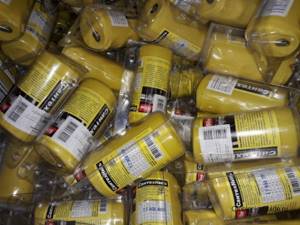
"SantekhNit", length 50 m.
Polyamide is a low-wrinkle synthetic fiber with an upper temperature limit of 130°C. Thread made from this material has increased wear resistance (10 times more than cotton) and resistance to many aggressive environments. When wound onto a thread, it can withstand a water pressure of 16 bar and a gas pressure of 8 bar.
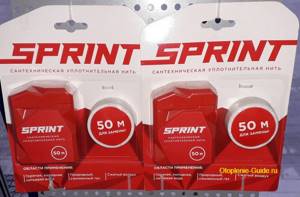
Sprit sealing thread complete with an additional 50 m skein.
Fluoroplastic is a fluorine-containing polymer with an upper temperature limit of more than 200°C. It is characterized by plasticity, heat resistance and high adhesion. Even more resistant to aggressive environments than polyamide. Polyamide thread, when wound on a thread, can withstand pressure up to 30 bar.

"Tangit Uni-Lock", length 80 m.
Any seal for threaded connections is impregnated with a special lubricant to ensure the reliability of the threaded connection. It is hygienic, does not decompose and prevents the development of corrosion. The connections assembled on such a thread are easy to adjust (adjust), which is very convenient if you need to install a tap, pressure gauge or fitting in the desired position.
At the same time, there is a danger that with a sharp change in temperature and increased vibration, the plumbing thread may become deformed, which will lead to a leak of liquid (gas). For this reason, professional plumbers of the Soviet school often prefer plumbing flax - an old, proven product, if handled skillfully, will never fail.
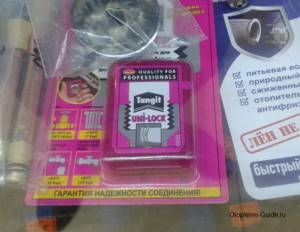
Tangit Uni-Lock.
Cold welding

A plasticine-like two-component composition based on epoxy resin, when connecting both parts, turns into a strong glue.
Advantages:
- some types of cold welding can be applied to a wet surface and under water;
- the resulting mass can be given the desired shape and processed after hardening.
The disadvantage is the high price.
Cold welding is indispensable when it is necessary to eliminate a leak, but there is no time for disassembly or the possibility of shutting off the water supply. Usually this solution is temporary.
Cold welding can restore a thread or a broken part. It is enough to apply the mixture to the damaged area, screw it on, and then unscrew the joining element and wait for it to cure.
O-rings and seals
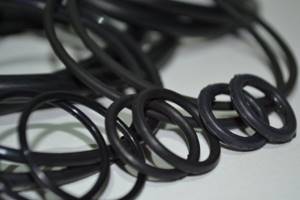
They are used if one of the parts has a limiting collar into which the end of the second rests. A gasket is placed between the contacting surfaces if the collar is internal, and a ring if it is external. Thread sealing is not required; on the contrary, this is considered an error.
It is better to use rings and gaskets made of soft silicone for cold water supply, and in the hot water supply system it is better to install seals made of heat-resistant rubber or paronite.
The advantage is the speed of installation: just install the gasket or put on the ring and tighten it. Disadvantage: due to the requirement for a collar, they are used in a narrow segment.
Rings and gaskets are used to seal connections when installing fittings and hoses with a union nut, and faucet axle boxes in mixers.
None of the materials considered can replace all the others. It is always better to keep a set of several seals on hand and use them depending on the situation.
When installing a new heating system, changing batteries or re-sealing threaded connections in the heating system before the start of the heating season, spend a couple of minutes of your attention on what materials the specialist will use in his work and what he will use to seal, for example, the pipe leading to the heating system of your Houses. Why is it important?
Linen is a biodegradable, short-lived material. We can all remember with affection the “grandfather’s” cast iron batteries that stood for 50 years, but today the operating conditions of the systems have radically changed. Replacement of such sealant for heating batteries will be required after 3-4 years.
There are many sealants for batteries and pipes of heating systems, belonging to different generations of thread sealants and having different applications (for more information on the classification of high-temperature anaerobic sealants, see the video). Flax is traditionally used in sealing heating pipes, when people ask the question “what is the best way to wrap heating pipes?” But what was good 30 years ago, in modern conditions is a manifestation of a low level of professionalism.

What basis is there for this statement?
Firstly: modern paints have a different composition, different from that which was characteristic of the samples of the Soviet period. They are completely unsuitable as impregnation for linen thread. Silicone is even less suitable for this purpose. The vinegar it contains leads to corrosion of the threads of heating pipes. As a result, rust occurs within the first months of using such a seal. Such sealants are especially not recommended for use on heating radiators and other similar heating systems.
Secondly: multi-storey new buildings are no longer Khrushchev’s five-story buildings. When pressing the heating pipes of a multi-storey building, a pressure exceeding the permissible 8 atmospheres for flax is applied. Therefore, in such cases it is contraindicated to use this sealant for heating joints.
Modern multi-storey construction involves the operation of internal highways at pressures of up to 16 atm.
As a result, the connections on the flax either burst when the flax swells, or do not withstand the operating pressures at which the heating pipe system is operated. If there are only a few such connections in your apartment, then this is still tolerable. But what about individual cottages in which the number of threaded connections reaches several hundred? Are you ready to withstand the invasion of plumbers into your home every 3-5 years? And can you be sure that none of the several hundred connections will leak or burst under pressure? Of course not! Therefore, we do not recommend using such sealants for threaded heating connections.
Another option for sealing threaded connections, which we do not recommend using for heating systems, is Fum tape. Supporters of FUM tape highlight its simple use - unlike flax, there is no need to use third-party materials to use it, it is easy to wind on a fitting, which is why it is still on the market. However, it is worth keeping in mind a number of disadvantages of using fum tape.
Among them:
Firstly, choosing a high-quality FUM tape is not easy. It should not tear or crumble. The correct FUM tape is elastic, it stretches easily and does not break into fibers. If you use low-quality material, then after a short period of time a leak cannot be avoided.
Secondly, such a material cannot withstand multidirectional loads that arise during thermal linear expansion and contraction of pipelines during cooling. Therefore, fum tape can only be used in cold pipeline systems.
Thirdly, such tape is demanding on the cleanliness and condition of the thread - if it is used for threads with a damaged (for example, rusted) surface or with carelessly applied notches, the tape may scuff and, as a result, lack of tightness.




